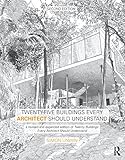Twenty-five buildings every architect should understand / Simon Unwin.
Material type: TextLondon ; New York : Routledge, Taylor & Francis Group 2015Edition: Second editionDescription: ix, 278 pages : illustrations, plans ; 29 cmContent type: text Media type: unmediated Carrier type: volumeISBN: 9781138781047 (hardback)Uniform titles: Twenty buildings every architect should understand Subject(s): Architecture, Modern -- 20th centuryLOC classification: NA680 .U59 2015
TextLondon ; New York : Routledge, Taylor & Francis Group 2015Edition: Second editionDescription: ix, 278 pages : illustrations, plans ; 29 cmContent type: text Media type: unmediated Carrier type: volumeISBN: 9781138781047 (hardback)Uniform titles: Twenty buildings every architect should understand Subject(s): Architecture, Modern -- 20th centuryLOC classification: NA680 .U59 2015| Item type | Current library | Shelving location | Call number | Copy number | Status | Date due | Barcode |
|---|---|---|---|---|---|---|---|
| Books | MEF Üniversitesi Kütüphanesi | Genel Koleksiyon | NA 680 .U59 2015 (Browse shelf (Opens below)) | Available | 0002678 |
"A revised and expanded edition of Twenty buildings every architect should understand."
Includes bibliographical references and index.
La Casa Del Ojo De Agua -- Neuendorf House -- Barcelona Pavillion -- Truss Wall House -- Endless House -- Farnsworth House -- La Congiunta -- Un Cabanon -- Esherick House -- Maison à Bordeaux -- Danteum -- Fallingwater -- Villa Savoye -- Kempsey Guest Studio -- Condominium One, the Sea Ranch -- Villa E.1027 -- Church of St Petri -- Villa Busk -- Villa Mairea -- Thermal Baths, Vals-- Ramesh House -- Bardi House -- Vitra Fire Station -- Mohrmann House -- Biocleave House.
Twenty-Five Buildings Every Architect Should Understand is an essential companion to Simon Unwin's Analysing Architecture, and part of the trilogy which also includes his Exercises in Architecture: Learning to Think as an Architect. Together the three books offer an introduction to the workings of architecture providing for the three aspects of learning: theory, examples and practice. Twenty-Five Buildings focusses on analysing examples using the methodology offered by Analysing Architecture, which operates primarily through the medium of drawing. In this second edition five further buildings have been added to the original twenty from an even wider geographical area, which now includes the USA, France, Italy, Mexico, Switzerland, Spain, Finland, Germany, Australia, Norway, Sweden, India and Japan. The underlying theme of Twenty-Five Buildings Every Architect Should Understand is the relationship of architecture to the human being, how it frames our lives and orchestrates our experiences; how it can help us make sense of the world and contribute to our senses of identity and place. Exploring these dimensions through a wide range of case studies that illustrate the rich diversity of twentieth and twenty-first century architecture, this book is essential reading for every architect.
In English.
